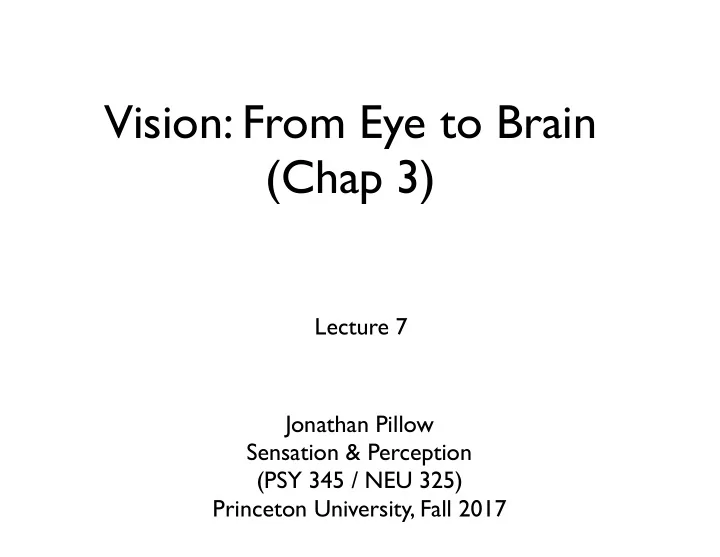

Vision: From Eye to Brain (Chap 3) Lecture 7 Jonathan Pillow Sensation & Perception (PSY 345 / NEU 325) Princeton University, Fall 2017
early visual pathway eye eye optic nerve optic chiasm optic tract lateral geniculate thalamus: nucleus (LGN) optic radiations primary visual cortex: cortex (“V1”) right visual left visual world world (aka “striate cortex”)
• Acuity : measure of finest visual detail that can be resolved
Measuring Visual Acuity Snellen E test • Herman Snellen invented this method for designating visual acuity in 1862 • Notice that the strokes on the E form a small grating pattern
Visual Acuity • in the lab • Acuity: The smallest spatial detail that can be resolved
Acuity eye doctor: 20 / 20 (your distance / avg person’s distance) for letter identification vision scientist: visual angle of one cycle of the finest grating you can see
stimulus on retina explaining acuity • striped pattern is a “sine wave grating” • visual system “samples” the grating at cone locations acuity limit : 1’ of arc cone spacing in fovea : 0.5’ of arc percept
more “channels”: spatial frequency channels spatial frequency : the number of cycles of a grating per unit of visual angle (usually specified in degrees) • think of it as: # of bars per unit length low frequency intermediate high frequency
Why sine gratings? • Provide useful decomposition of images Technical term: Fourier decomposition (But the real reason: some neuroscientists read a math book and decided it would be cool to apply some fancy math to vision science!)
Fourier decomposition • mathematical decomposition of an image (or sound) into sine waves. reconstruction: “image” 1 sine wave 2 sine waves 3 sine waves 4 sine waves
“Fourier Decomposition” theory of V1 claim : role of V1 is to do “Fourier decomposition”, i.e., break images down into a sum of sine waves • Summation of two spatial sine waves • any pattern can be broken down into a sum of sine waves
Fourier decomposition • mathematical decomposition of an image (or sound) into sine waves. Low Frequencies Original image High Frequencies
original low medium high
Retinal Ganglion Cells: tuned to spatial frequency Response of a ganglion cell to sine gratings of different frequencies
The contrast sensitivity function Human contrast sensitivity illustration of this sensitivity
Image Illustrating Spatial Frequency Channels
Image Illustrating Spatial Frequency Channels
If it is hard to tell who this famous person is, try squinting or defocusing “Lincoln illusion” Harmon & Jules 1973
“Gala Contemplating the Mediterranean Sea, which at 30 meters becomes the portrait of Abraham Lincoln (Homage to Rothko)” - Salvador Dali (1976)
“Gala Contemplating the Mediterranean Sea, which at 30 meters becomes the portrait of Abraham Lincoln (Homage to Rothko)” - Salvador Dali (1976)
lateral geniculate nucleus (LGN): one on each side of the brain • this is where axons of retinal ganglion cells synapse Organization: • represents contralateral visual field • segregated into eye- specific layers • segregated into M and P layers Ipsilateral : Referring to the same side of the body Contralateral : Referring to the opposite side of the body
Primary Visual Cortex • Striate cortex: known as primary visual cortex, or V1 • “Primary visual cortex” = first place in cortex where visual information is processed (Previous two stages: retina and LGN are pre-cortical)
Receptive Fields: monocular vs. binocular - LGN cells: responds to one eye or the other, never both LGN V1 - V1 cells: can respond to input from both eyes (but V1 neurons still tend to have a preferred eye - they spike more to input from one eye)
Topography: mapping of objects in space onto the visual cortex • contralateral representation - each visual field (L/R) represented in opposite hemisphere • cortical magnification - unequal representation of fovea vs. periphery in cortex - a misnomer, because “magnification” already present in retina (that is, the amount of space in cortex for each part of the visual field is given by the number of fibers coming in from LGN)
Recommend
More recommend